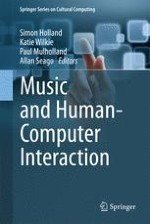2013 | OriginalPaper | Buchkapitel
6. The Haptic Bracelets: Learning Multi-Limb Rhythm Skills from Haptic Stimuli While Reading
verfasst von : Anders Bouwer, Simon Holland, Mat Dalgleish
Erschienen in: Music and Human-Computer Interaction
Verlag: Springer London
Aktivieren Sie unsere intelligente Suche, um passende Fachinhalte oder Patente zu finden.
Wählen Sie Textabschnitte aus um mit Künstlicher Intelligenz passenden Patente zu finden. powered by
Markieren Sie Textabschnitte, um KI-gestützt weitere passende Inhalte zu finden. powered by
